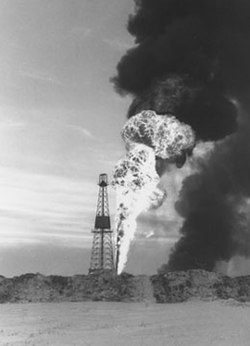Leduc No. 1
| Leduc No. 1 | |
|---|---|

Leduc #1 well
|
|
| Type | crude oil discovery in Alberta, Canada |
| Location | Alberta, Canada |
| Nearest city | Leduc County |
| Established | 1990 |
| Built | 1946 |
| Governing body | Parks Canada |
| Website | http://www.leducnumber1.com/ |
Leduc No. 1 was a major crude oil discovery made near Leduc, Alberta, Canada on February 13, 1947. It provided the geological key to Alberta's most prolific conventional oil reserves and resulted in a boom in petroleum exploration and development across Western Canada. The discovery transformed the Alberta economy; oil and gas supplanted farming as the primary industry and resulted in the province becoming one of the richest in the country. Nationally, the discovery allowed Canada to become self-sufficient within a decade and ultimately a major exporter of oil.
The discovery followed years of exploratory failures throughout the province. Imperial Oil had spent millions of dollars drilling 133 dry holes in the previous years as only minor discoveries were made. Leduc No. 1 discovered that oil was trapped in what became known as the Nisku Formation and resulted in numerous major discoveries across the prairies. Leduc No. 1 produced 317,000 barrels of oil and 323 million cubic feet of natural gas before it was decommissioned in 1974, and was part of the Leduc-Woodbend oilfield that has produced over 300 million barrels of oil total.
Billions of investment dollars flowed into Alberta and were followed by massive immigration to the province following the discovery. Alberta's two major cities saw their populations double within a few years. Calgary grew into a major financial centre and within two decades had the highest number of millionaires in Canada, per capita. The provincial capital of Edmonton, immediately northeast of the discovery, became a major petroleum production centre. A farming community with fewer than 900 residents in 1947, Leduc grew to become Alberta's 13th city, while several towns, including Devon and Swan Hills, were founded to support workers in the oil and gas industry.
Oil was known to exist in Alberta for many centuries. First Nations peoples used it to pitch canoes and to act as a medicinal ointment. Pioneer settlers to southern Alberta in the late 19th century noticed that an oily film occasionally covered pools of water, and that the air had unusual odours at times. In 1911, Ontario-born settler William Herron identified the nature of the odours from his time working in oil fields in Pennsylvania. He convinced Calgary businessman Archibald Dingman and Member of Parliament R. B. Bennett to visit the site near Turner Valley. The trio gathered four other investors, formed the Calgary Petroleum Products Company, Ltd. and began developing the region in search of oil. The company drilled three wells beginning in 1913, and on May 14, 1914, the third struck a significant reserve at a depth of 820 metres (2,690 ft). Excitement reached a fevered pitch in Calgary once word of the Turner Valley strike reached town. Over 500 oil exploration companies were formed within days, the majority of which existed only to bilk unwitting citizens by selling shares in companies that owned no land and had no intention of drilling for oil.
...
Wikipedia
